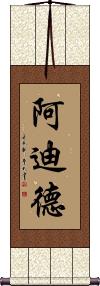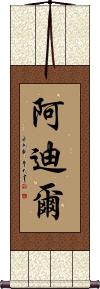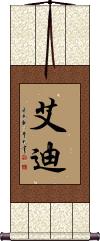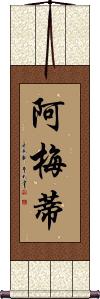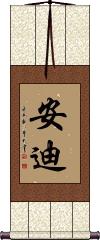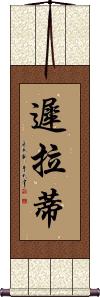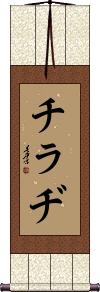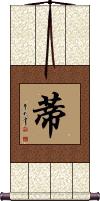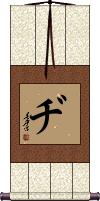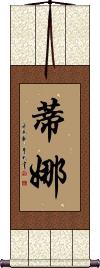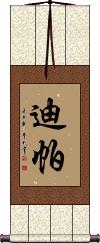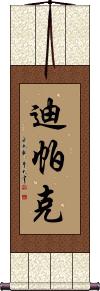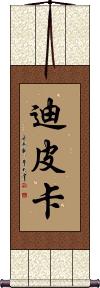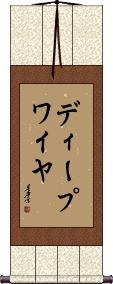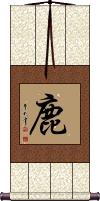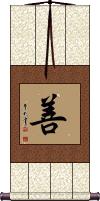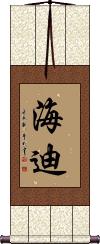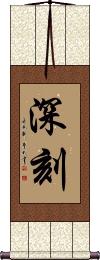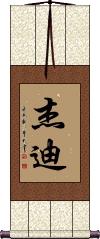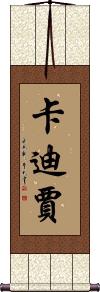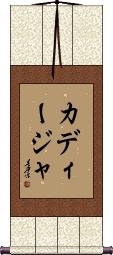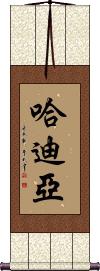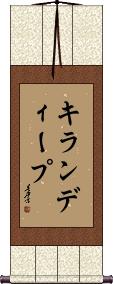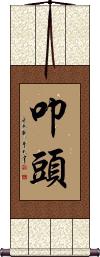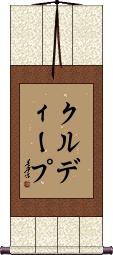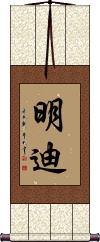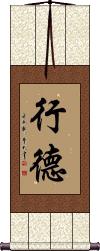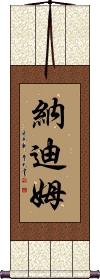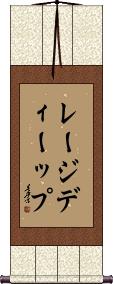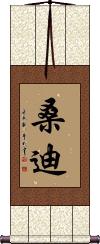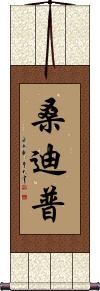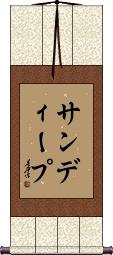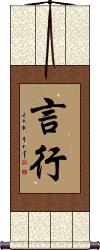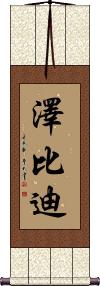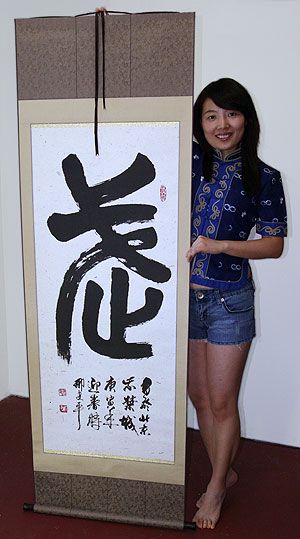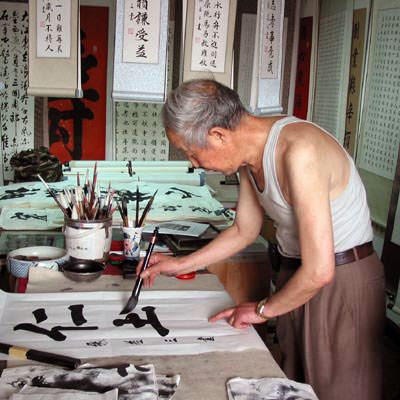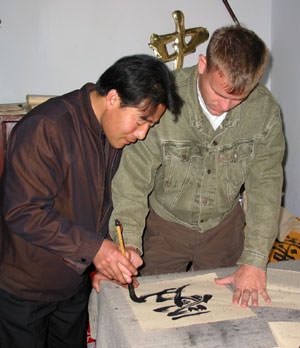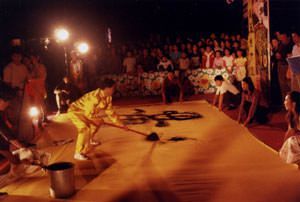The Name Dee in Japanese/Chinese on a Custom-Made Wall Scroll.
Click the "Customize" button next to your name below to start your personalized dee calligraphy artwork...
Switched to secondary search mode due to lack of results using primary.
These secondary results may not be very accurate. Try a different but similar meaning word or phrase for better results. Or...
Look up Dee in my Japanese Kanji & Chinese Character Dictionary(My dictionary is a different system then the calligraphy search you just tried)
If you want a special phrase, word, title, name, or proverb, feel free to contact me, and I will translate your custom calligraphy idea for you.
1. Adeed
2. Adeel
3. Aidee
4. Amedee
5. Andee
6. Chiradee
7. Dee
8. Deena
9. Deepa
10. Deepak
11. Deepanksha
12. Deepika
13. Deepthi
14. Deer
15. Far-Sighted in Deep Thought
18. Haydee
19. Achieve Inner Peace; Find Deep Understanding
20. Intense / Serious / Deep / Profound
21. Jaydee
22. Khadeeja
23. Khadeejah
24. Kirandeep
26. Kuldeep
27. Mindee
28. Morality of Deed
29. Nadeem
30. Nadeen
31. Rajdeep
32. Sandee
33. Sandeep
34. Sundeep
35. Words and Deeds
36. Zebidee
Adeed
Adeed
Adeel
Adeel
Aidee
Aidee
Amedee
Amedee
Andee
Andee
Chiradee
Chiradee
Deena
Deena
Deepa
Deepa
Deepak
Deepak
Deepanksha
Deepika
Deepika
Deepthi
Deer
鹿 is the single character for deer in Chinese, Japanese Kanji, and old Korean Hanja.
In Japanese, this can refer especially to the sika deer of Japan (Cervus Nippon).
Far-Sighted in Deep Thought
深謀遠慮 is a Chinese, Japanese, and Korean proverb that means “deep plans and distant thoughts,” “to plan far ahead,” or “far sight and deep design.”
One Good Deed Each Day
一日一善 is a Chinese, Japanese Kanji, and old Korean Hanja phrase that suggests doing a good deed each day or doing one good turn a day.
It literally reads, “One Day, One Good (Deed).”
Goodness / Good Deed
善 means goodness, virtue, good deed, charitable, benevolent, well-disposed, nice, pleasant, kind, or simply, “good.”
善 is the kind of good that applies to someone's good character, or a good person in general.
Referring to someone with this word means that they have a well-aimed moral compass, and are charitable, giving, wise, and honest. Basically, this is a blanket statement for every good trait a human can have or all the things that make someone good.
In another context, it can mean to improve or perfect something or refer to someone who is good at something.
Haydee
Haydee
Achieve Inner Peace; Find Deep Understanding
寧靜而致遠 is five characters from a longer ten-character proverb composed by Zhuge Liang about 1800 years ago.
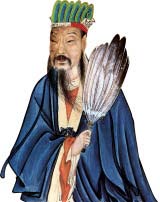
诸葛亮 Zhuge Liang
The proverb means “Your inner peace/tranquility/serenity will help you see or reach far (into the world).”
The last word means “far” but the deeper meaning is that you will surpass what you can currently see or understand. Perhaps even opening up vast knowledge and understanding of complex ideas.
Intense / Serious / Deep / Profound
深刻 is a Chinese word that is the form of intense that describes a person who is deep, serious, and a true thinker.
If you find yourself contemplating the world and coming up with profound ideas, this might be the word for you. In some contexts (especially Korean), it can mean seriousness, gravity, or acuteness.
In Japanese, this can mean “serious problem” or can be a rare given name, Misa. You should not use this if your audience is Japanese.
Jaydee
Jaydee
Khadeeja
Khadeeja
Khadeejah
Khadeejah
Kirandeep
Kirandeep
Kowtow - The deepest bow
叩頭 is the term that seems to be known worldwide as kowtow.
In Japanese and Chinese, it simply means a deep bow, especially one so low that one's head touches the ground in submission. However, in western culture, it has sometimes come to mean “giving in” or “surrendering to someone else's will.” Sometimes even said of a person who stoops to flattery at the expense of their dignity.
I don't know if you would really want this on a wall scroll, but enough people have searched for this term on our website that I guess it was time to add it. It just feels strange to see such a word on a wall scroll, so please order with caution. 叩頭 is antiquated in both Japanese and Chinese. The act is seldom done anymore and is seen as an ancient ritual.
Kuldeep
Kuldeep
Mindee
Mindee
Morality of Deed
The idea of “morality of deed” goes along with 行德 or “wu de” (martial morality or virtues of the warrior).
Here, the first character is a representation of the actions or deeds that you engage in.
The second character refers to morality or virtue.
This translates better in English in the opposite order, as the Chinese order is literally “deed morality.”
See Also: Morality of Mind | Martial Morality
Nadeem
Nadeem
Nadeen
Nadeen
Rajdeep
Rajdeep
Sandee
Sandee
Sandeep
Sandeep
Sundeep
Sundeep
Words and Deeds
言行 means words and actions, what one says and what one does, speech and behavior, or words and deeds in Chinese, Japanese Kanji, and old Korean Hanja.
Zebidee
Zebidee
The following table may be helpful for those studying Chinese or Japanese...
| Title | Characters | Romaji (Romanized Japanese) | Various forms of Romanized Chinese | |
| Adeed | 阿迪德 | ā dí dé / a1 di2 de2 / a di de / adide | a ti te / atite | |
| Adeed | アディード | adiido / adido | ||
| Adeel | 阿迪爾 阿迪尔 | ā dí ěr / a1 di2 er3 / a di er / adier | a ti erh / atierh | |
| Adeel | アディール | adiiru / adiru | ||
| Aidee | 艾迪 | ài dí / ai4 di2 / ai di / aidi | ai ti / aiti | |
| Aidee | エーディー | eedii / edi | ||
| Amedee | 阿梅蒂 | ā méi dì a1 mei2 di4 a mei di ameidi | a mei ti ameiti |
|
| Amedee | アメディー | amedii / amedi | ||
| Andee | 安迪 | ān dí / an1 di2 / an di / andi | an ti / anti | |
| Andee | アンディー | andii / andi | ||
| Chiradee | 遲拉蒂 迟拉蒂 | chí lā dì chi2 la1 di4 chi la di chiladi | ch`ih la ti chihlati chih la ti |
|
| Chiradee | チラヂ | chi ra di / chiradi | ||
| Dee | 蒂 | dì / di4 / di | ti | |
| Dee | ヂ | di | ||
| Deena | 蒂娜 | dì nà / di4 na4 / di na / dina | ti na / tina | |
| Deena | ディーナ | diina / dina | ||
| Deepa | 迪帕 | dí pà / di2 pa4 / di pa / dipa | ti p`a / tipa / ti pa | |
| Deepa | ディーパ | diipa / dipa | ||
| Deepak | 迪帕克 | dí pà kè di2 pa4 ke4 di pa ke dipake | ti p`a k`o tipako ti pa ko |
|
| Deepak | ヂーパク | diipaku / dipaku | ||
| Deepanksha | 迪番克莎 | dí fān kè shā di2 fan1 ke4 sha1 di fan ke sha difankesha | ti fan k`o sha tifankosha ti fan ko sha |
|
| Deepika | 迪皮卡 | dí pí kǎ di2 pi2 ka3 di pi ka dipika | ti p`i k`a tipika ti pi ka |
|
| Deepika | ディープワイヤ | diipuwaiya / dipuwaiya | ||
| Deepthi | ディープティ | diiputi / diputi | ||
| Deer | 鹿 | shika / ka | lù / lu4 / lu | |
| Far-Sighted in Deep Thought | 深謀遠慮 深谋远虑 | shinbouenryo / shinboenryo shinboenryo / shinboenryo | shēn móu yuǎn lǜ shen1 mou2 yuan3 lu:4 shen mou yuan lu: shenmouyuanlu: | shen mou yüan lü shenmouyüanlü |
| One Good Deed Each Day | 一日一善 | ichi nichi ichi zen ichinichiichizen | yī rì yī shàn yi1 ri4 yi1 shan4 yi ri yi shan yiriyishan | i jih i shan ijihishan |
| Goodness Good Deed | 善 | zen | shàn / shan4 / shan | |
| Haydee | 海迪 | hǎi dí / hai3 di2 / hai di / haidi | hai ti / haiti | |
| Haydee | ヘイディー | heidii / heidi | ||
| Achieve Inner Peace; Find Deep Understanding | 寧靜而致遠 宁静而致远 | níng jìng ér zhì yuǎn ning2 jing4 er2 zhi4 yuan3 ning jing er zhi yuan ningjingerzhiyuan | ning ching erh chih yüan ningchingerhchihyüan |
|
| Intense Serious Deep Profound | 深刻 | shinkoku / misa | shēn kè / shen1 ke4 / shen ke / shenke | shen k`o / shenko / shen ko |
| Jaydee | 杰迪 | jié dí / jie2 di2 / jie di / jiedi | chieh ti / chiehti | |
| Jaydee | ジェイディー | jeidii / jeidi | ||
| Khadeeja | 卡迪賈 卡迪贾 | kǎ dí jiǎ ka3 di2 jia3 ka di jia kadijia | k`a ti chia katichia ka ti chia |
|
| Khadeeja | カディージャ | kadiija / kadija | ||
| Khadeejah | 哈迪亞 哈迪亚 | hā dí yà ha1 di2 ya4 ha di ya hadiya | ha ti ya hatiya |
|
| Khadeejah | カディージャ | kadiija / kadija | ||
| Kirandeep | 基蘭迪普 基兰迪普 | jī lán dí pǔ ji1 lan2 di2 pu3 ji lan di pu jilandipu | chi lan ti p`u chilantipu chi lan ti pu |
|
| Kirandeep | キランディープ | kirandiipu / kirandipu | ||
| Kowtow - The deepest bow | 叩頭 叩头 | koutou / koto | kòu tóu / kou4 tou2 / kou tou / koutou | k`ou t`ou / koutou / kou tou |
| Kuldeep | 庫爾迪普 库尔迪普 | kù ěr dí pǔ ku4 er3 di2 pu3 ku er di pu kuerdipu | k`u erh ti p`u kuerhtipu ku erh ti pu |
|
| Kuldeep | クルディープ | kurudiipu / kurudipu | ||
| Mindee | 明迪 | míng dí / ming2 di2 / ming di / mingdi | ming ti / mingti | |
| Mindee | ミンディー | mindii / mindi | ||
| Morality of Deed | 行德 | xíng dé / xing2 de2 / xing de / xingde | hsing te / hsingte | |
| Nadeem | 納迪姆 纳迪姆 | nà dí mǔ na4 di2 mu3 na di mu nadimu | na ti mu natimu |
|
| Nadeem | ナディーム | nadiimu / nadimu | ||
| Nadeen | 納丁 纳丁 | nà dīng / na4 ding1 / na ding / nading | na ting / nating | |
| Nadeen | ナディーン | nadiin / nadin | ||
| Rajdeep | 拉杰迪普 | lā jié dí pǔ la1 jie2 di2 pu3 la jie di pu lajiedipu | la chieh ti p`u lachiehtipu la chieh ti pu |
|
| Rajdeep | レージディーップ | reejidiippu rejidipu | ||
| Sandee | 桑迪 | sāng dí / sang1 di2 / sang di / sangdi | sang ti / sangti | |
| Sandee | サンディ | sandi | ||
| Sandeep | 桑迪普 | sāng dí pǔ sang1 di2 pu3 sang di pu sangdipu | sang ti p`u sangtipu sang ti pu |
|
| Sandeep | サンヂープ | sandiipu / sandipu | ||
| Sundeep | 桑迪普 | sāng dí pǔ sang1 di2 pu3 sang di pu sangdipu | sang ti p`u sangtipu sang ti pu |
|
| Sundeep | サンディープ | sandiipu / sandipu | ||
| Words and Deeds | 言行 | genkou / genko | yán xíng / yan2 xing2 / yan xing / yanxing | yen hsing / yenhsing |
| Zebidee | 澤比迪 泽比迪 | zé bǐ dí ze2 bi3 di2 ze bi di zebidi | tse pi ti tsepiti |
|
| Zebidee | ゼビディー | zebidii / zebidi | ||
| In some entries above you will see that characters have different versions above and below a line. In these cases, the characters above the line are Traditional Chinese, while the ones below are Simplified Chinese. | ||||
